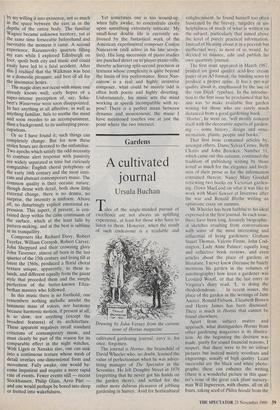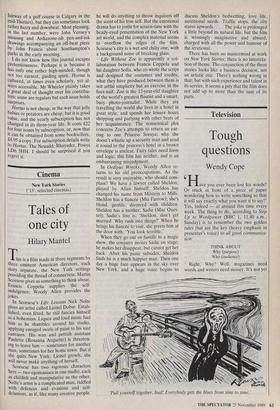Gardens
A cultivated journal
Ursula Buchan
ales of the single-minded pursuit of excellence are not always an uplifting experience, at least for those who have to listen to them. However, when the result of such endeavour is a readable and Drawing by John Verney from the current issue of Hortus magazine cultivated gardening journal, envy is, for once; forgotten.
The journal is Hortus, the brainchild of David Wheeler who, no doubt, learned the value of perfectionism when he was adver- tising manager of The Spectator in the Seventies. He left Doughty Street in 1979 (regretting that he never got his hands on the garden there), and settled for the rather more dubious pleasures of jobbing gardening in Surrey. Avid for horticultural enlightenment, he found himself too often frustrated by the brevity, turgidity or un- helpfulness of much of what is written on the subject, particularly that aimed above the level of purely practical information. Instead of bleating about it in a peevish but ineffectual way, as most of us would, he decided to finance, edit and publish his own quarterly journal.
The first issue appeared in March 1987, printed on good quality acid-free cream paper in an AS format, the binding sewn to produce a proper spine.. It has a pre-war quality about it, emphasised by the use of the 'van Dijck' typeface. In the introduc- tion to the first issue he proclaimed that his aim was 'to make available fine garden writing for those who are rarely much distanced from a good gardening book... .' 'Norms', he went on. 'will mostly concern itself with the decorative aspects of garden- ing — some history, design and orna- mentation, plants, people and books.'
That first issue contained articles by, amongst others, Dame Sylvia Crowe, Beth Chatto and John Brookes. Number 11, which came out this autumn, continued the tradition of publishing writing by those noted as much for the elegance and liveli- ness of their prose as for the information contained therein: Nancy Mary Goodall reviewing two books on Victorian garden- ing, Dawn MacLeod on what it was like to work with Mairi Sawyer at Inverewe after the war and Ronald Blythe writing an optimistic essay on autumn.
Mr Wheeler has been faithful to his ideal expressed in the first journal. In each issue, there have been long, leisurely biographic- al sketches resulting from conversations with some of the most interesting and influential of living gardeners: Graham Stuart Thomas, Valerie Finnis, John Cod- rington, Lady Anne Palmer; equally long and reflective book reviews, and even articles about the place of gardens in literature. I never knew (because he barely mentions his garden in the volumes of autobiography) how keen a gardener was Leonard Woolf, or that the last entry in Virginia's diary read, 'L. is doing the rhododendrons....' In recent issues, the place of the garden in the writings of Jane Austen, Ronald Firbank, Elizabeth Bowen and Henry James has been discussed. There is much in Hortus that cannot be found elsewhere.
Apart from subject matter and approach, what distinguishes Hortus from other gardening magazines is its illustra- tion. At the beginning the decision was made, partly for sound financial reasons, I suspect, that there were to be no colour pictures but instead mainly woodcuts and engravings, usually of high quality. Least successful are the black and white photo- graphs; these can enhance the writing (there is a wonderful picture in this quar- ter's issue of the great rock plant nursery- man Will Ingwerson, with chums, all on all fours, taking seed of Phlox hoodii from the fairway of a golf course in Calgary in the mid-Thirties), but they can sometimes look rather fuzzy and downbeat. Most pleasing, in the last number, were John Verney's amusing and Ardizzone-ish pen-and-ink drawings accompanying an off-beat piece by John Francis about Southampton's parks in the early morning.
I do not know how this journal escapes pretentiousness. Perhaps it is because it has only one rather high-minded, though not too earnest, guiding spirit. Hortus is cultured, at times even scholarly, yet al- ways accessible. Mr Wheeler plainly takes a great deal of thought over his contribu- tors; some are regulars but each issue holds
surprises, •
Hortus is not cheap, in the way that jelly babies or potatoes are cheap, but it is good value, and the yearly subscription has not changed in its three-year life. It costs £22 for four issues by subscription, or, now that it can be obtained from some booksellers, £4.95 a copy. For subscription details write to lioitus, The Neuadd, Rhayader, Powys LD6 5H1-1.• I should be surprised if you regret it.











































































 Previous page
Previous page